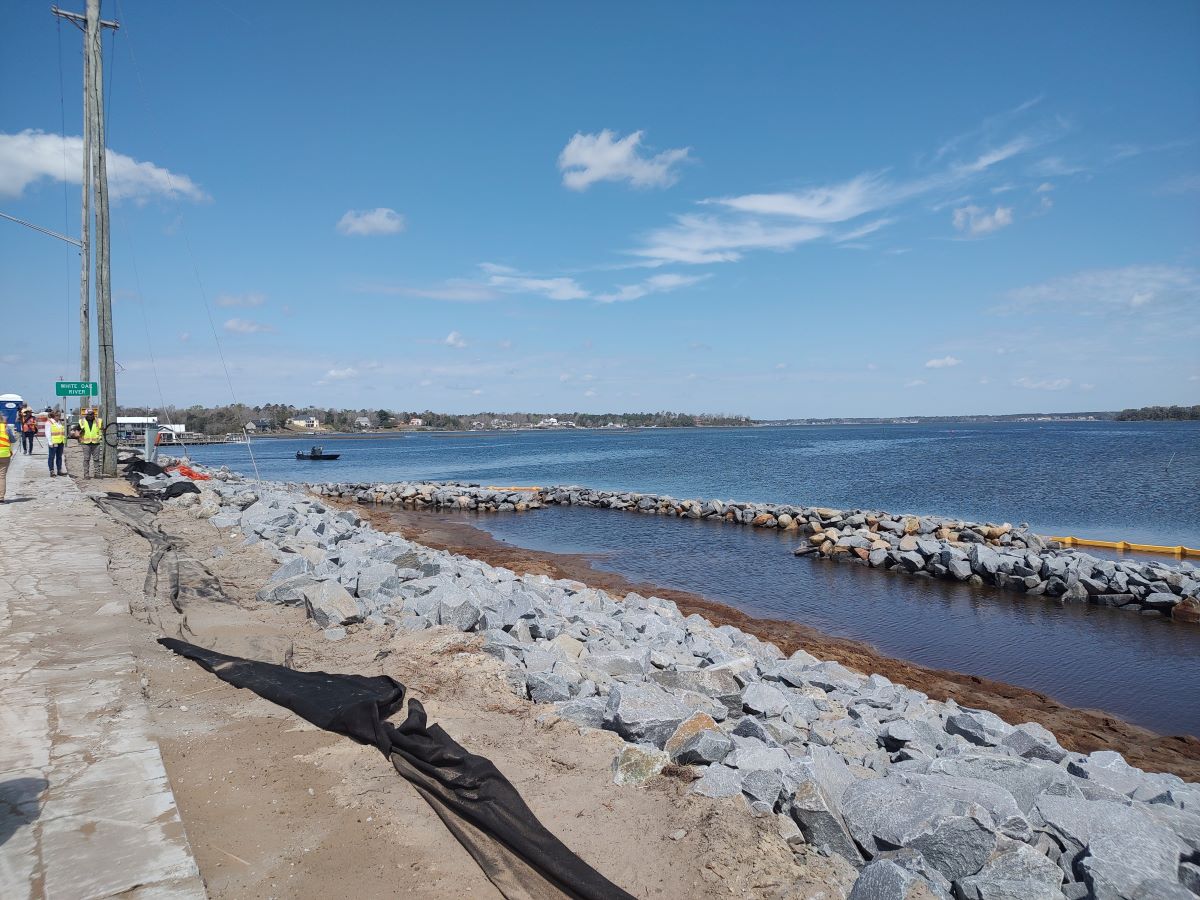
The North Carolina Department of Transportation, citing its commitment to consider nature-based solutions for resiliency, has partnered with the nonprofit North Carolina Coastal Federation on a living shoreline project along the causeway between Swansboro and Cedar Point to protect N.C. 24.
The Coastal Federation publishes Coastal Review.
Supporter Spotlight
This is NCDOT’s first living shoreline, said Brian Lipscomb, stormwater engineer with the agency’s hydraulics unit, during an event Thursday in downtown Swansboro’s Bicentennial Park to show the media the project’s progress.
“This project for DOT really represents our commitment to looking into and considering nature-based solutions for providing resiliency and climate adaptation in our state’s highway infrastructure,” he said.
This living shoreline, expected to be compete this summer, is one of three being built along the causeway with the other two managed by the Coastal Federation. The first living shoreline was completed in July and the third will be built sometime this year. The total for all three is $3.6 million.
Lipscomb explained that living shorelines combine engineered and natural features to reduce wave energy and reduce erosion along a shoreline.
“They’ve been proven to be much more resilient, and less prone to failures than traditional bulkheads, as well as providing some environmental uplift with creation of some diverse fisheries habitat,” he said, adding that living shorelines also can also improve water quality, reduce erosion through nutrient uptake of the vegetation and the oysters that’ll eventually come in and be in the area as well can filter water.
Supporter Spotlight
That section of N.C. Highway 24 was selected for the project because it is a vital route for hurricane evacuations and for military installations like Marine Corps Base Camp Lejeune. The causeway has been vulnerable to extreme storm events in the past and suffered damage on numerous occasions, Lipscomb noted.
Lipscomb said the NCDOT project includes a quarter-acre of new salt marsh and 900 feet of granite rock and oyster structure sill to serve as a wave breaker. Work on the project began in December, and Lipscomb expects it to be completed by this summer, coming in right at about $2 million.
The project was made possible through funding from the North Carolina General Assembly, NCDOT bridge maintenance money and a grant from the National Fish and Wildlife Foundation awarded to the Coastal Federation in partnership with the DOT.
Dr. Lexia Weaver, coastal scientist and living shoreline program director for the Coastal Federation, explained that one of the organization’s main goals in protecting and restoring the coast is “to make living shorelines the norm for shoreline stabilization, and this project is another example of many that are moving that goal forward.”
She expressed the organization’s gratitude to DOT’s commitment and decision to pursue “this more resilient, environmentally friendly approach to erosion control.
“Living shorelines have proven time and time again to work significantly better are more cost effective and more resilient to the effects of storms compared to the traditionally used bulkheads and seawalls that have hardened our shoreline and reduced our valuable salt marsh and oyster habitats in the process,” she said.
Planning for the project began in 2019 when NCDOT and the Coastal Federation worked together to submit a proposal to the National Fish and Wildlife Foundation. That grant was awarded in 2020, and the project team began to design and permit the three living shorelines along the causeway.
The first living shoreline, which spans 300 feet, was built by Native Shorelines in 2022 using their patent-pending QuickReef material. The DOT-led living shoreline project are the second and the third living shorelines planned to be built along the causeway will total 500 feet in length.
“These living shorelines, they will help to reduce wave energy and protect the roadway while at the same time while protecting and restoring valuable salt marsh and oyster habitats. So we look forward to seeing many more of these DOT living shoreline projects being implemented along our coast,” Weaver said.
While looking at the project after the media event, Lipscomb said DOT had a longstanding history with Coastal Federation, including projects to build saltwater wetlands in Manteo and a restoration project in Beaufort. He said the relationship was especially helpful on NCDOT’s first living shoreline project that was not part of a Coastal Federation project.
Lipscomb said since the project was approved, construction proceeded smoothly. He explained that design changes were needed because of utility conflicts and environmental reasons.
“I think the agencies have been really happy with what they’ve seen,” Lipscomb said.
DOT will likely consider using living shorelines in other projects, he said. Once the shoreline in Swansboro is finished, Lipscomb said monitoring would continue, “but we’ve seen this from other projects across the state, across the country, that the shorelines are really good and really help for resilience and stand up to traditional hardening methods.”







